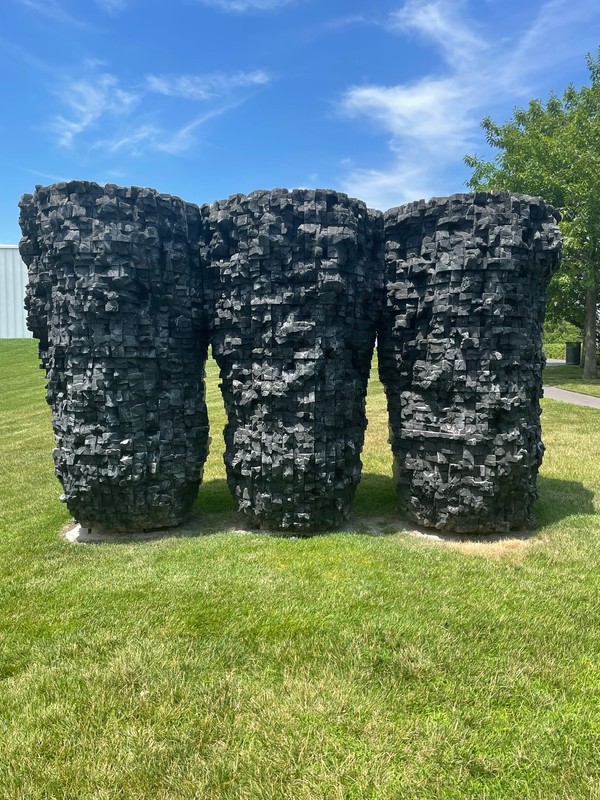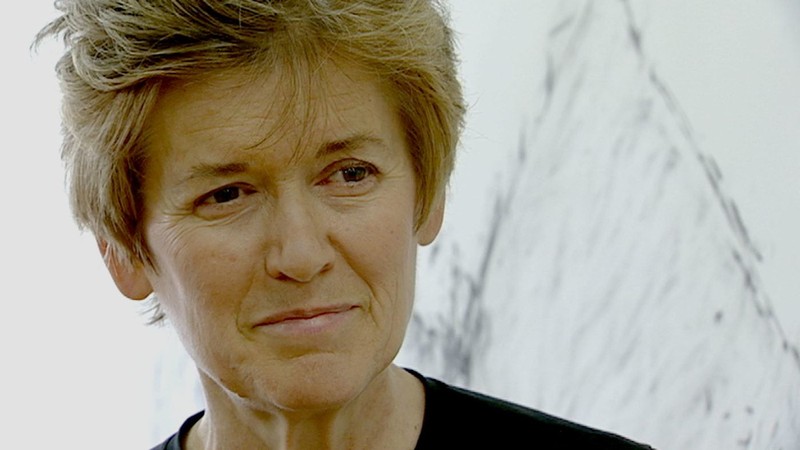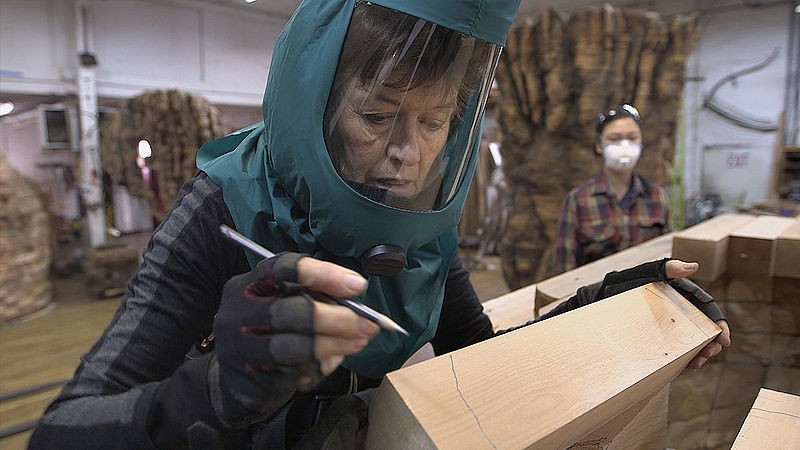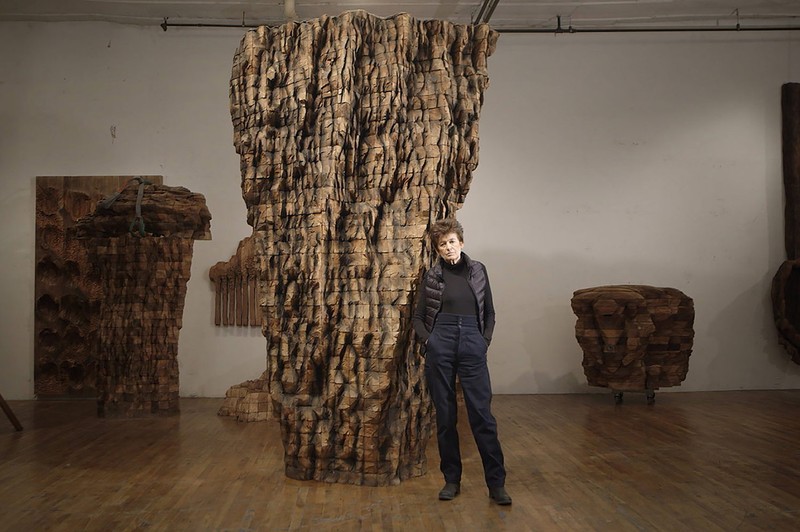Three Bowls
Introduction
Text-to-speech Audio
German-born American artist Ursula von Rydingsvard created Three Bowls in 1990, using 4-by-4 cedar beams. Rather than sketching her designs, von Rydingsvard cuts the individual beams freehand with a circular saw then stacks and glues the pieces together, creating an irregular, organic quality. She then adds a mixture of graphite and linseed oil after assembly, then lightly scrubs the surface with steel wool to achieve a distressed texture and unique finish while also protecting the wood. The monolithic presence and utilitarian nature of the interlocking sculptures of Three Bowls is perhaps a connection to the ancestral history of von Rydingsvard’s family of Polish farmers, in which she often uses as inspiration for her work. Three Bowls was purchased by the Nelson-Atkins Museum of Art in 1999 from Galerie Lelong in New York.
Images
Three Bowls by Ursula von Rydingsvard at the Nelson-Atkins Museum of Art, Kansas City, Missouri

Artist Ursula von Rydingsvard

Ursula von Rydingsvard freehands her cuts in 4x4 cedar beams.

Ursula von Rydingsvard standing next to "Dumna"

Backstory and Context
Text-to-speech Audio
Ursula von Rydingsvard was born on July 26, 1942 in Germany, where her father was a forced-labor farmer for the Nazi’s during World War II. After the war was over, her family spent five years in refugee camps before coming to America in December 1950 and settling in Connecticut. With a long family history of Polish peasant farmers, Von Rydingsvard never understood life outside of blue-collar work and didn’t realize the potential of becoming an artist until she came to New York in her 30’s. In 1975 she earned a Master’s degree in Fine Art from Columbia University and received the Fulbright-Hays Travel Grant, and quickly started sculpting for both solo and group exhibitions.
After first studying welding, von Rydingsvard then discovered the natural beauty of wood in ways in which she could manipulate the shape and texture to evoke emotion. She uses memories of her childhood and tributes to her Polish ancestry, which gives her a sense of will, inspiration, and desire to work with her hands. Wood in particular is familiar to her as she recounts the years she spent in refugee camps, where everything was made of wood:
“We stayed in wooden barracks, rough wooden floors, rough wooden walls and rough wooden ceilings.”
The majority of von Rydingsvard’s work uses 4-by-4 wood beams and created with ideas solely in her head. Rather than sketching her designs, she marks lines directly onto the wood, cuts them into pieces, and shapes them with a circular saw before adhering them together. The scale of her work, in using thousands of individual pieces to create a monumental work of art, gives her countless opportunities to make the shapes complex. Through careful decisions and detail, her goal is ultimately to embrace the body and psyche.
As one of the only women who sculpt on such a monumental scale, Ursula von Rydingsvard has had her work displayed world-wide and has received countless awards and honors throughout her life. Some of her most notable honors include the Lifetime Achievement Award by the International Sculpture Center in New Jersey (2014), the Lifetime Achievement Award for Excellence in the Arts by the National Museum of Women in the Arts in Washington D.C. (2019), and the Gold Medal for Merit to Culture, Gloria Artis, Ministry of Culture, National Heritage, and Sport in Warsaw, Poland (2021).
Three Bowls was first commissioned for the Walker Art Center in Minneapolis, Minnesota and completed in 1990, then exhibited there until 1997. It then moved to Yorkshire Sculpture Park in the United Kingdom for a solo exhibit in August 1997 until March 1998, the Nelson-Atkins Museum of Art in Kansas City from May 1998 to March 1999, then the Indianapolis Museum of Art from May 1999 to April 2000. It was purchased in 1999 by the William Rockhill Nelson Trust for the Nelson-Atkins Museum of Art through the generosity of the Hall Family Foundation, the George H. and Elizabeth O. Davis Fund, G. Kenneth Baum, and Judy and Alan Kosloff.
Gallery Label for Three Bowls
“Ursula von Rydingsvard sculpts intuitively and without drawings or models to guide her process. She creates each sculpture directly from a mental image that evolves as she works. The roughly hewn, steeply vertical surfaces of Three Bowls bring to mind weathered, rocky cliffs. Von Rydingsvard reinforces this impression by saturating the wood with Black graphite, which silvers as it ages. The artist stated, "I am drawn to that part of the world where manmade walls erode in a way where there is no longer a strict line between that which man has made and that which nature has made.”
Sources
Museum Label, "Three Bowls", Nelson-Atkins Museum of Art. Accessed July 8th 2022.
Three Bowls, The Nelson-Atkins Museum of Art. Accessed August 30th, 2022. https://art.nelson-atkins.org/objects/11119/three-bowls.
Segal, Mark. Ursula von Rydingsvard Film to Be Shown at Parrish, The East Hampton Star. February 13th, 2020. Accessed August 30th, 2022. https://www.easthamptonstar.com/arts/2020213/ursula-von-rydingsvard-film-to-be-shown-parrish.
CV, Ursula von Rydingsvard. Accessed August 30th, 2022. https://ursulavonrydingsvard.net/uvr-cv.
Close Up. The sculptures of Ursula von Rydingsvard, Avrotros. August 15th, 2020. Accessed August 30th, 2022. https://www.avrotros.nl/close-up/gemist/detail/de-sculpturen-van-ursula-von-rydingsvard-15-08-2020/.
Photo by David Trowbridge
https://art21.org/artist/ursula-von-rydingsvard/
https://www.avrotros.nl/close-up/gemist/detail/de-sculpturen-van-ursula-von-rydingsvard-15-08-2020/
https://www.easthamptonstar.com/arts/2020213/ursula-von-rydingsvard-film-to-be-shown-parrish
